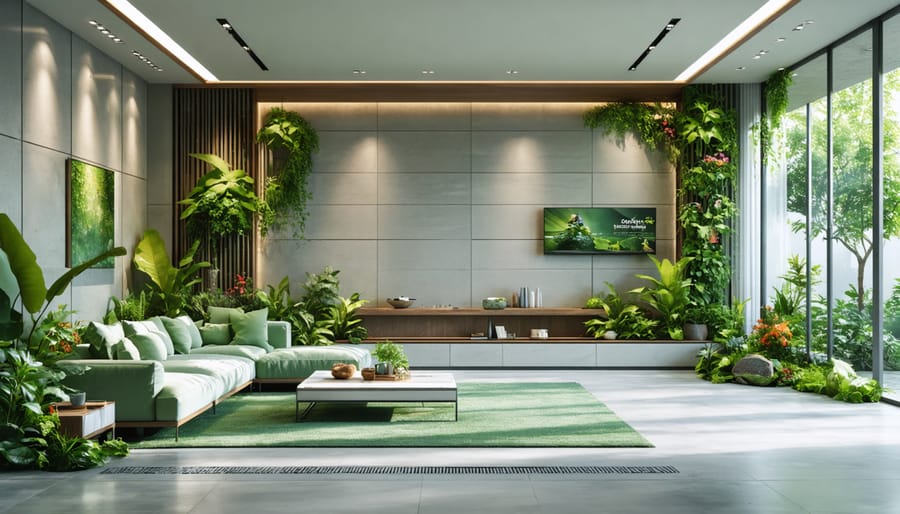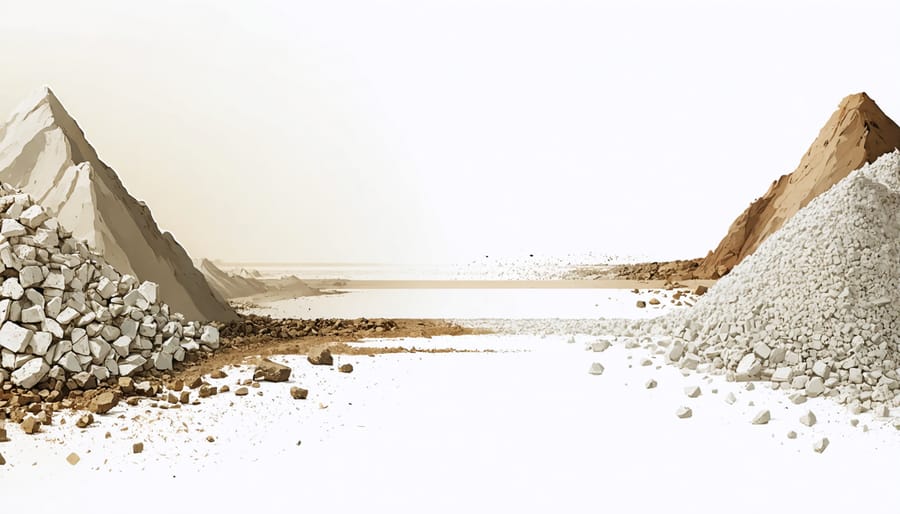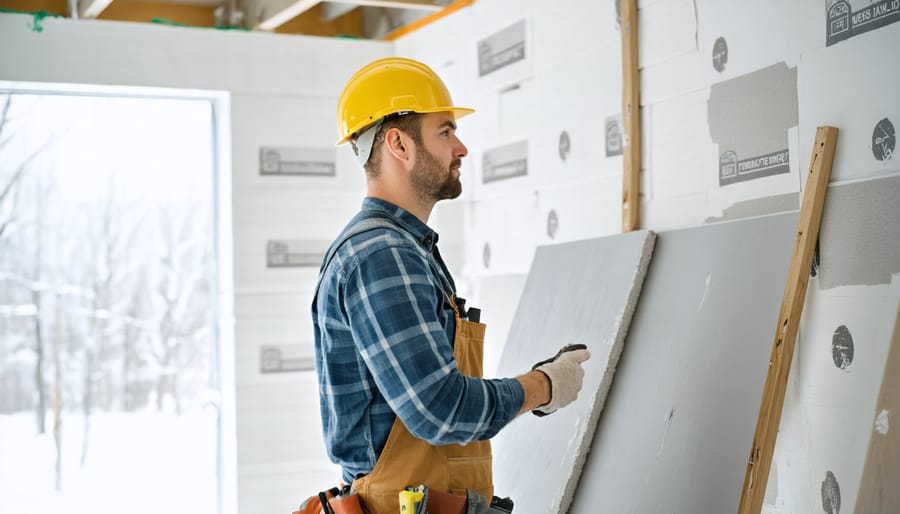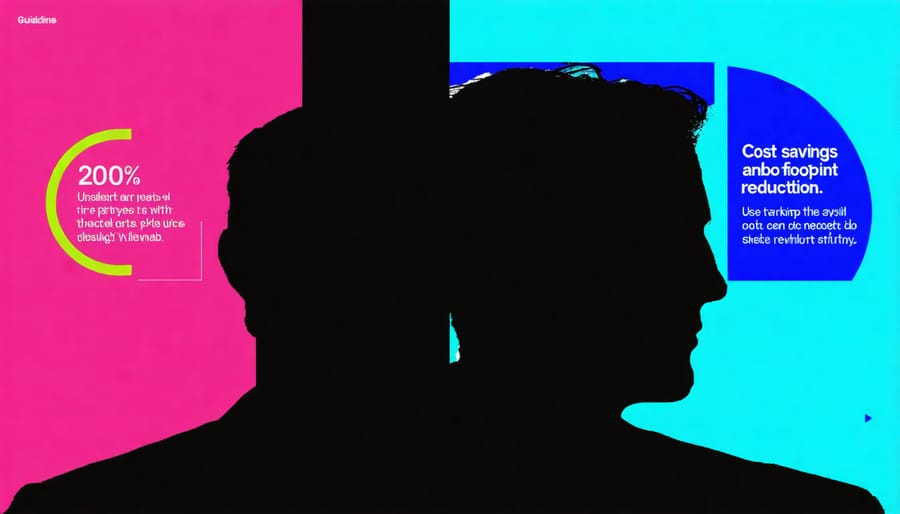
Eco-Friendly Drywall That Slashes Your Carbon Footprint (And Energy Bills)
Transform your home’s environmental impact with eco-friendly drywall, a cornerstone of sustainable construction that goes beyond traditional building materials. As homeowners increasingly seek eco-friendly home features, innovative drywall alternatives made from recycled materials, agricultural byproducts, and natural fibers are revolutionizing interior construction.
These sustainable alternatives reduce landfill waste, decrease carbon emissions during manufacturing, and create healthier indoor environments by eliminating toxic compounds found in conventional drywall. From mushroom-based panels to recycled paper gypsum boards, today’s eco-friendly drywall options offer superior moisture resistance, improved air quality, and enhanced soundproofing capabilities – all while maintaining the durability and ease of installation that contractors and DIY enthusiasts expect.
Whether you’re renovating a single room or building a new home, choosing eco-friendly drywall represents a significant step toward sustainable living without compromising on performance or aesthetic appeal.
What Makes Drywall Eco-Friendly?
Recycled Content and Natural Materials
Modern eco-friendly drywall incorporates significant amounts of recycled materials, making it a sustainable choice for conscientious homeowners. Many manufacturers now use post-industrial recycled gypsum and recovered paper products in their production process, reducing landfill waste and environmental impact. Some brands contain up to 95% recycled content, combining perfectly with other natural insulation materials for a truly green building solution.
Natural alternatives to traditional drywall include materials like clay plaster, earthen walls, and magnesium oxide boards. Clay plaster offers excellent moisture control and can be sourced locally, while earthen walls provide superior thermal mass properties. Magnesium oxide boards are particularly durable and naturally resistant to mold and fire, making them increasingly popular in eco-conscious construction projects. These alternatives not only reduce environmental impact but also create healthier indoor air quality for your living spaces.

Low-Impact Manufacturing
Eco-friendly drywall manufacturers are revolutionizing production methods to minimize environmental impact. Modern facilities employ closed-loop manufacturing systems that recycle water and reduce waste throughout the production process. Many plants now run on renewable energy sources like solar and wind power, significantly reducing their carbon footprint.
Advanced material processing techniques allow manufacturers to use recycled content without compromising quality. Some facilities capture and reuse gypsum dust that would otherwise go to waste, while others incorporate post-consumer recycled paper for the outer backing layers. Water conservation systems can reduce usage by up to 30% compared to traditional manufacturing methods.
Transportation emissions are also being addressed through strategic facility locations and optimized delivery routes. Some manufacturers even use electric vehicles for local deliveries and partner with rail services for long-distance transport, further reducing the environmental impact of getting materials to construction sites.
Top Eco-Friendly Drywall Options
Recycled-Content Drywall
Recycled-content drywall represents a significant advancement in sustainable building materials, incorporating post-industrial and post-consumer waste into its manufacturing process. These innovative panels typically contain recycled paper facing and recycled gypsum core materials, reducing landfill waste and minimizing the need for virgin resources.
Many manufacturers now offer products containing up to 95% recycled content, with the recycled materials coming from various sources including demolished buildings, manufacturing scraps, and even waste from coal-fired power plants. The paper facing often incorporates recycled newspapers and cardboard, while the gypsum core can include materials recovered from construction sites or industrial processes.
These eco-friendly panels perform just as well as traditional drywall in terms of durability, fire resistance, and sound insulation. They’re also priced competitively with conventional options, making them an attractive choice for environmentally conscious builders and homeowners. Additionally, many recycled-content drywall products qualify for LEED credits, adding value to green building projects.
When selecting recycled-content drywall, look for products with third-party certifications that verify their recycled content claims and environmental benefits.
Natural Gypsum Alternatives
Several sustainable alternatives to traditional gypsum are making waves in the eco-friendly construction industry. Magnesium oxide boards, made from natural magnesium and other minerals, offer superior fire resistance and moisture protection while being completely recyclable. Hemp-based drywall, created from industrial hemp fibers mixed with lime, provides excellent insulation and naturally regulates humidity.
Another innovative option is wheat board, manufactured from agricultural waste products like wheat straw. This alternative not only repurposes farm byproducts but also creates a durable, formaldehyde-free wall material. Recycled paper-based panels, composed of compressed recycled paper and non-toxic binding agents, offer another environmentally conscious choice.
These alternatives typically cost 15-30% more than traditional gypsum board but offset the price difference through enhanced durability, better indoor air quality, and reduced environmental impact. Many also qualify for green building certifications, potentially increasing property value.
Mold-Resistant Green Options
For environmentally conscious homeowners concerned about mold, several green drywall options offer excellent resistance while maintaining eco-friendly credentials. Paper-free gypsum boards made with recycled materials incorporate natural antimicrobial ingredients like copper and zinc, preventing mold growth without harmful chemicals. Magnesium oxide boards, derived from sustainable sources, naturally resist mold and mildew while providing superior moisture protection. These green alternatives often include recycled agricultural fibers and minerals that create an inhospitable environment for mold spores. Some manufacturers now offer boards treated with organic compounds like tea tree oil and citrus extracts, providing natural antimicrobial protection. While these options typically cost 15-20% more than standard drywall, their long-term durability and health benefits make them a smart investment, especially in moisture-prone areas like bathrooms, basements, and laundry rooms.
Installation and Maintenance Tips

DIY Installation Considerations
Before starting your eco-friendly drywall installation, ensure you have proper safety equipment, including a dust mask, safety glasses, and work gloves. Begin by measuring your space carefully and calculating the required materials with a 10% waste allowance for cuts and mistakes.
Start installation from the ceiling if applicable, then work your way down the walls. Use green screws specifically designed for eco-friendly drywall, as they provide better grip and resist corrosion. Space screws approximately 8 inches apart on ceilings and 12 inches apart on walls.
When cutting eco-friendly drywall, score the face paper with a utility knife and snap it back firmly. Cut through the back paper to complete the break. For electrical outlets and fixtures, measure carefully and cut holes using a drywall saw.
Apply eco-friendly joint compound in thin layers, allowing each coat to dry completely before applying the next. Use paper tape for joints rather than mesh tape, as it’s more environmentally friendly and creates stronger seams. Sand between coats using a fine-grit sandpaper, being careful not to damage the drywall surface.
Remember to dispose of any waste materials according to local recycling guidelines, as many eco-friendly drywall products are recyclable.
Long-Term Care and Durability
Eco-friendly drywall, when properly maintained, can last just as long as conventional drywall – typically 30-50 years or more. To maximize its lifespan, keep indoor humidity levels between 30-50% and address any water leaks promptly. Regular visual inspections can help catch potential issues early, especially in areas prone to moisture like bathrooms and basements.
Unlike traditional drywall, many eco-friendly options actually resist mold and mildew naturally, thanks to their mineral-based or recycled material composition. This resistance not only extends the product’s life but also contributes to better indoor air quality over time.
To maintain your eco-friendly drywall, use gentle cleaning methods – a soft cloth with mild soap and water works best. Avoid harsh chemicals, as they’re not only unnecessary but can potentially compromise the material’s natural properties. Small repairs can be handled with eco-friendly joint compound and follow the same techniques as traditional drywall repair.
For best results, pair your eco-friendly drywall with proper ventilation and moisture control systems, especially in high-humidity areas. This preventive approach will ensure your sustainable choice remains durable and effective for decades to come.
Cost and Environmental Benefits

Initial vs. Long-Term Costs
While eco-friendly drywall typically costs 10-15% more than conventional options upfront, the long-term benefits often make it a smart investment that can help you save money and the planet. For example, moisture-resistant eco-drywall reduces the risk of mold growth, potentially saving thousands in future remediation costs. Energy-efficient varieties can lower heating and cooling expenses by up to 20% annually. Additionally, many sustainable drywall products come with longer warranties and greater durability, meaning less frequent replacement. Some regions offer tax incentives or rebates for using eco-friendly building materials, which can offset the initial cost difference. When calculating your budget, consider these long-term savings alongside the upfront investment to make an informed decision.
Environmental Impact Reduction
Eco-friendly drywall significantly reduces environmental impact through several measurable benefits. A typical 2,000-square-foot home using green drywall can save up to 1,200 pounds of carbon emissions compared to traditional drywall installation. Many eco-friendly drywall products contain at least 95% recycled content, diverting thousands of pounds of waste from landfills annually.
These sustainable alternatives often carry important environmental certifications, including GREENGUARD Gold for low chemical emissions and LEED credits for sustainable building materials. Some manufacturers report up to 50% less energy consumption during production compared to conventional drywall manufacturing.
Water conservation is another key benefit, with recycled drywall production using approximately 30% less water than traditional methods. Many eco-friendly options are also designed for easy recycling at the end of their lifecycle, creating a closed-loop system that further reduces environmental impact. Their lighter weight also means reduced transportation emissions, with some manufacturers reporting up to 25% lower shipping-related carbon footprint.
Making the switch to eco-friendly drywall is more than just a trend – it’s a meaningful step toward sustainable building practices that benefit both our homes and the environment. By choosing green drywall alternatives, you’re reducing landfill waste, improving indoor air quality, and often creating more durable living spaces. Whether you opt for recycled-content drywall, magnesium oxide boards, or natural clay panels, each option brings its own set of environmental advantages.
Remember that while some eco-friendly options may have a higher upfront cost, they often pay for themselves through increased durability, better energy efficiency, and improved home value. Plus, many sustainable drywall products now match or exceed the performance of traditional gypsum boards, making them practical choices for any construction project.
As we continue to face environmental challenges, every sustainable choice in home building matters. By selecting eco-friendly drywall for your next construction or renovation project, you’re not just building walls – you’re building a better future for generations to come. Take the time to explore these green alternatives and make an informed decision that aligns with both your project needs and environmental values.
